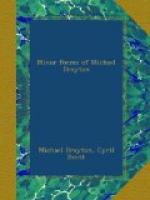In 1593 and 1594 Drayton also published his earliest pieces on the mediaeval theme of the ‘Falls of the Illustrious’; they were Peirs Gavesson and Matilda the faire and chaste daughter of the Lord Robert Fitzwater. Here Drayton followed in the track of Boccaccio, Lydgate, and the Mirrour for Magistrates, walking in the way which Chaucer had derided in his Monkes Tale: and with only too great fidelity does Drayton adapt himself to the dullnesses of his model: fine rhetoric is not altogether wanting, and there is, of course, the consciousness that these subjects deal with the history of his beloved country, but neither these, nor Robert, Duke of Normandy (1596), nor Great Cromwell, Earl of Essex (1607 and 1609), nor the Miseries of Margaret (1627) can escape the charge of tediousness.[12] England’s Heroical Epistles were first published in 1597, and other editions, of 1598, 1599, and 1602, contain new epistles. These are Drayton’s first attempt to strike out a new and original vein of English poetry: they are a series of letters, modelled on Ovid’s Heroides,[13] addressed by various pairs of lovers, famous in English history, to each other, and arranged in chronological order, from Henry II and Rosamond to Lady Jane Grey and Lord Guilford Dudley. They are, in a sense, the most important of Drayton’s writings, and they have certainly been the most popular, up to the early nineteenth century. In these poems Drayton foreshadowed, and probably inspired, the smooth style of Fairfax, Waller, and Dryden. The metre, the grammar, and the thought, are all perfectly easy to follow, even though he employs many of the Ovidian ‘turns’ and ‘clenches’. A certain attempt at realization of the different characters is observable, but the poems are fine rhetorical exercises rather than realizations of the dramatic and passionate possibilities of their themes. In 1596, Drayton, as we have seen, published the Mortimeriados, a kind of epic, with Mortimer as its hero, of the wars between King Edward II and the Barons.[14] It was written in the seven-line stanza of Chaucer’s Troilus and Cressida and Spenser’s Hymns.




